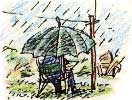ReflectionsMonday, 21st July 2003, West Yorkshire |
![]()
![]()
![]()
![]() Rocks | History |
Workshop |
Links | Home
Page
Rocks | History |
Workshop |
Links | Home
Page
![]()

At last I get a chance to get out to do a quick sketch and I'm not going to let a few specks of rain and a glowering grey cloud over the boundary oak put me off. As it turns out, it is worth all the effort of putting up the umbrella (with the brass ring at the apex tied to the washing line with an old bootlace, so that it doesn't fall over) because it starts raining the moment that I start drawing.
My pen is blotted by even the odd drop of rain so I start in watercolour, without any initial drawing in pencil.
 I
don't want to capture the 'effect' of reflections in the pond,
I don't want to do an inadequate tribute to Monet (though I guess
I can't help having him looking over my shoulder as I tackle a subject
like this - I can almost smell the cigarette smoke); I want to observe
exactly what is there.
I
don't want to capture the 'effect' of reflections in the pond,
I don't want to do an inadequate tribute to Monet (though I guess
I can't help having him looking over my shoulder as I tackle a subject
like this - I can almost smell the cigarette smoke); I want to observe
exactly what is there.
You'd think that would be reasonably straightforward: just record the colour of each part of the scene. But there are so many complications.
When I focus on the sky reflected in the pond I start correcting the colour balance and begin to see the sky as blue, the clouds as white and grey: in fact in this reflection they're all shades of, how can I put it?
bluey-browny-reddish-greenish-greyish-Prussian-blue
When I focus on the plants growing under water I start to see the local colour of the stems and roots - orangey and rice white. But again they're filtered by the colour of the water.
Then rain stirs the surface and spreading concentric rings add to the complexity!
I'm going to need some practice on this. It feels impossible when I'm working on it, faced with the real thing in all it's subtlety and complexity, but when I look at the sketch later I feel that at least I've captured something of the subject.
Baggy the Blackbird
 Our
resident blackbird is in a terrible mess featherwise,
I assume because of feather mite. He's almost bald on the top of his head
- don't I know that feeling - and his feathers below are so ruffled that
he looks as if he's wearing baggy shorts. But he's a good hunter: he rejects
one worm, possibly because it's too big, but soon finds another that does
suit him further up the lawn.
Our
resident blackbird is in a terrible mess featherwise,
I assume because of feather mite. He's almost bald on the top of his head
- don't I know that feeling - and his feathers below are so ruffled that
he looks as if he's wearing baggy shorts. But he's a good hunter: he rejects
one worm, possibly because it's too big, but soon finds another that does
suit him further up the lawn.
 He
pecks and shakes it, butchering it into sections an inch or so long. He
flies towards his nest in next door's garden. As he perches for a moment
on our shed he flexes his tail, revealing just two feathers.
He
pecks and shakes it, butchering it into sections an inch or so long. He
flies towards his nest in next door's garden. As he perches for a moment
on our shed he flexes his tail, revealing just two feathers.
Message in a Dropping
 There's
been a break in my work on the little meadow area. Right in the middle
of the piece that I recently dug over three or four large fox
scats (droppings) have appeared. It's typical of foxes to leave their
mark on some new and preferably smelly feature in the landscape, for instance
on the stump of a newly-felled tree. This freshly dug square of soil must
be perfect.
There's
been a break in my work on the little meadow area. Right in the middle
of the piece that I recently dug over three or four large fox
scats (droppings) have appeared. It's typical of foxes to leave their
mark on some new and preferably smelly feature in the landscape, for instance
on the stump of a newly-felled tree. This freshly dug square of soil must
be perfect.
 The
clayey appearance of the dropping and that long tail to at the end of
it (which the other droppings didn't in fact have, they don't all have
it) are typical of fox.
The
clayey appearance of the dropping and that long tail to at the end of
it (which the other droppings didn't in fact have, they don't all have
it) are typical of fox.
Now that we no longer have hens next door I don't feel that our night
visitor can do much mischief.
![]()
![]() Next page | Previous page |
This day two
years ago | This month |
Nature Diary |
Home
Page
Next page | Previous page |
This day two
years ago | This month |
Nature Diary |
Home
Page
![]()